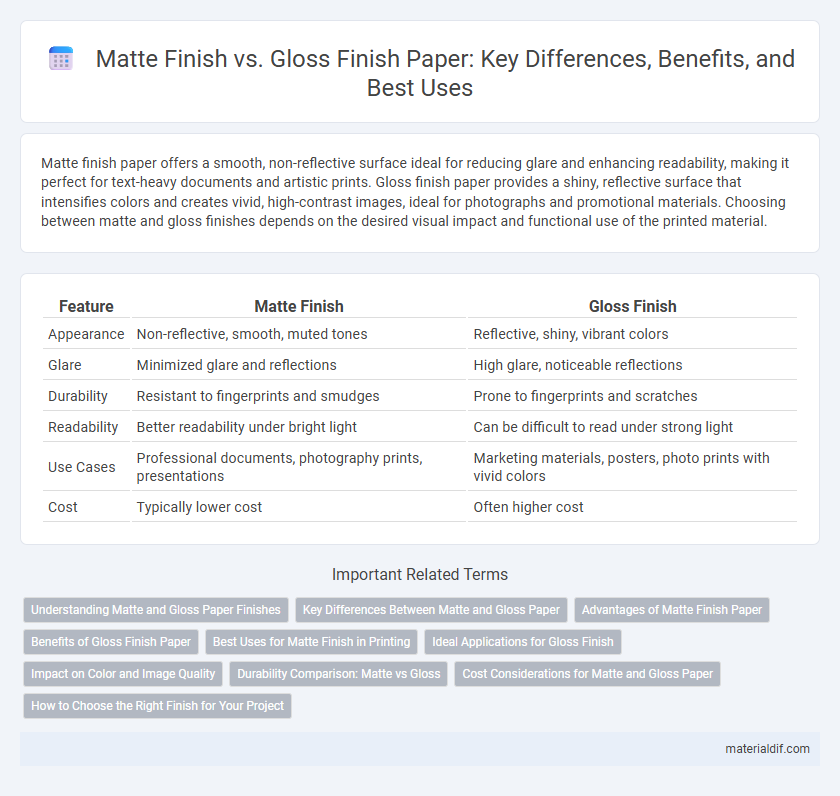Matte finish paper offers a smooth, non-reflective surface ideal for reducing glare and enhancing readability, making it perfect for text-heavy documents and artistic prints. Gloss finish paper provides a shiny, reflective surface that intensifies colors and creates vivid, high-contrast images, ideal for photographs and promotional materials. Choosing between matte and gloss finishes depends on the desired visual impact and functional use of the printed material.
Table of Comparison
| Feature | Matte Finish | Gloss Finish |
|---|---|---|
| Appearance | Non-reflective, smooth, muted tones | Reflective, shiny, vibrant colors |
| Glare | Minimized glare and reflections | High glare, noticeable reflections |
| Durability | Resistant to fingerprints and smudges | Prone to fingerprints and scratches |
| Readability | Better readability under bright light | Can be difficult to read under strong light |
| Use Cases | Professional documents, photography prints, presentations | Marketing materials, posters, photo prints with vivid colors |
| Cost | Typically lower cost | Often higher cost |
Understanding Matte and Gloss Paper Finishes
Matte finish paper features a non-reflective surface with a smooth texture that reduces glare and enhances readability, making it ideal for text-heavy documents and professional presentations. Gloss finish paper offers a shiny, reflective surface that intensifies colors and sharpens image details, often preferred for photographs, marketing materials, and vibrant visual prints. Choosing between matte and gloss finishes depends on the desired aesthetic impact, print clarity, and practical use of the printed material.
Key Differences Between Matte and Gloss Paper
Matte paper features a non-reflective surface that minimizes glare and provides a smooth, muted appearance, ideal for text-heavy documents and professional presentations. Gloss paper offers a shiny, reflective finish that enhances color vibrancy and sharpness, making it suitable for photos and visual artwork. Key differences include matte's superior readability and reduced fingerprints versus gloss's heightened color saturation and susceptibility to glare.
Advantages of Matte Finish Paper
Matte finish paper offers superior glare resistance, ensuring readability under various lighting conditions, which benefits presentations and printed materials requiring clarity. Its smooth, non-reflective surface minimizes fingerprints and smudges, maintaining a clean, professional appearance over time. Matte paper also enhances color depth and contrast subtly, providing a sophisticated and elegant look ideal for art prints and high-quality photographs.
Benefits of Gloss Finish Paper
Gloss finish paper enhances color vibrancy and sharpness, making images and text appear more vivid and eye-catching. Its smooth, reflective surface offers better resistance to fingerprints, moisture, and smudges, improving durability and maintaining a polished look. This finish is ideal for marketing materials like brochures and photos where visual impact and professionalism are crucial.
Best Uses for Matte Finish in Printing
Matte finish paper is ideal for printing materials that require minimal glare and a sophisticated, subdued appearance, such as business cards, brochures, and art prints. It enhances readability and reduces reflections, making it perfect for text-heavy documents and photographs with subtle tones. Matte paper also resists fingerprints and smudges, ensuring a clean and professional look in presentations and marketing materials.
Ideal Applications for Gloss Finish
Gloss finish paper is ideal for vibrant and high-impact visuals, making it perfect for marketing materials like brochures, flyers, and posters that require eye-catching color reproduction. Its reflective surface enhances image sharpness and contrast, which benefits photo books, magazines, and presentations needing a polished, professional look. Gloss finishes also work well for packaging and labels where durability and a sleek appearance can attract consumer attention.
Impact on Color and Image Quality
Matte finish paper reduces glare and reflections, enhancing readability by diffusing light, which results in softer, more subdued color tones and less vibrant image quality. Gloss finish paper, with its smooth, shiny surface, intensifies color saturation and contrast, delivering sharper and more vivid images that attract visual attention. The choice between matte and gloss finish significantly impacts color perception and image clarity, influencing overall print effectiveness in marketing materials and photography.
Durability Comparison: Matte vs Gloss
Matte finish paper offers superior scratch resistance and hides fingerprints better, enhancing long-term durability in handling and display. Gloss finish paper, while prone to visible scratches and fingerprints, provides a protective coating that resists moisture and smudging, making it suitable for environments requiring stain resistance. Choosing between matte and gloss depends on balancing durability factors like abrasion resistance against moisture protection for specific usage scenarios.
Cost Considerations for Matte and Gloss Paper
Matte paper generally costs less than gloss paper due to simpler coating processes and lower manufacturing expenses. Gloss finish paper requires additional materials and technology to achieve its shiny, reflective surface, increasing production costs. Bulk purchases of matte paper often yield more significant savings for large-scale printing projects compared to gloss finishes.
How to Choose the Right Finish for Your Project
Selecting the right paper finish depends on the project's purpose and desired aesthetic. Matte finish offers a non-reflective surface ideal for readability and a sophisticated, muted look, perfect for text-heavy documents and artistic prints. Gloss finish provides vibrant colors and sharp details, making it suitable for photographs, marketing materials, and projects requiring eye-catching visuals.
Matte Finish vs Gloss Finish Infographic

 materialdif.com
materialdif.com